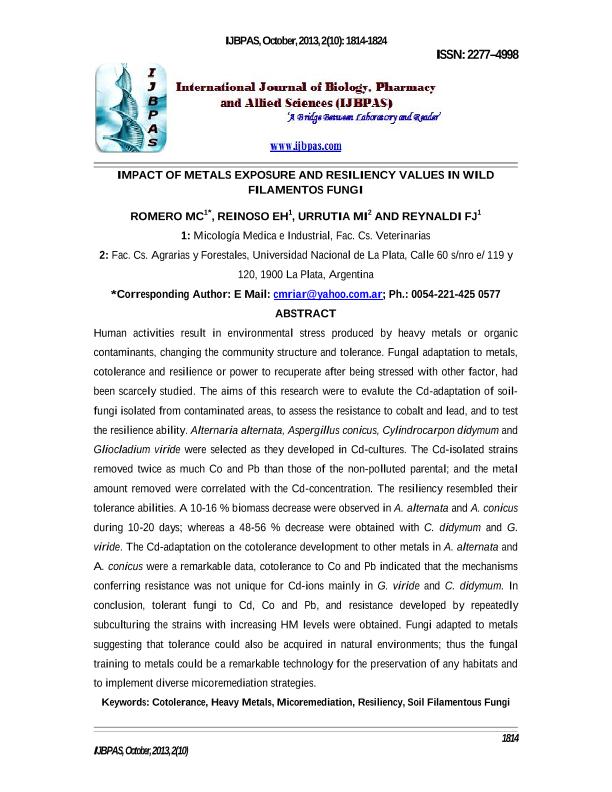Mostrar el registro sencillo del ítem
dc.contributor.author
Romero, Maria Cristina

dc.contributor.author
Reinoso E. H.
dc.contributor.author
Urrutia, María Inés

dc.contributor.author
Reynaldi, Francisco José

dc.date.available
2020-04-02T18:59:34Z
dc.date.issued
2013-09
dc.identifier.citation
Romero, Maria Cristina; Reinoso E. H.; Urrutia, María Inés; Reynaldi, Francisco José; Impact of metals exposure and resiliency values in wild filamentous fungi; Biology, Pahrmacy and Allied Sciences; International Journal of Biology, Pharmacy and Allied Sciences; 2; 9-2013; 1814-1824
dc.identifier.issn
2277-4998
dc.identifier.uri
http://hdl.handle.net/11336/101709
dc.description.abstract
Human activities result in environmental stress produced by heavy metals or organic contaminants, changing the community structure and tolerance. Fungal adaptation to metals, cotolerance and resilience or power to recuperate after being stressed with other factor, had been scarcely studied. The aims of this research were to evalute the Cd-adaptation of soilfungi isolated from contaminated areas, to assess the resistance to cobalt and lead, and to test the resilience ability. Alternaria alternata, Aspergillus conicus, Cylindrocarpon didymum and Gliocladium viride were selected as they developed in Cd-cultures. The Cd-isolated strains removed twice as much Co and Pb than those of the non-polluted parental; and the metal amount removed were correlated with the Cd-concentration. The resiliency resembled their tolerance abilities. A 10-16 % biomass decrease were observed in A. alternata and A. conicus during 10-20 days; whereas a 48-56 % decrease were obtained with C. didymum and G. viride. The Cd-adaptation on the cotolerance development to other metals in A. alternata and A. conicus were a remarkable data, cotolerance to Co and Pb indicated that the mechanisms conferring resistance was not unique for Cd-ions mainly in G. viride and C. didymum. In conclusion, tolerant fungi to Cd, Co and Pb, and resistance developed by repeatedly subculturing the strains with increasing HM levels were obtained. Fungi adapted to metals suggesting that tolerance could also be acquired in natural environments; thus the fungal training to metals could be a remarkable technology for the preservation of any habitats and to implement diverse micoremediation strategies.
dc.format
application/pdf
dc.language.iso
eng
dc.publisher
Biology, Pahrmacy and Allied Sciences
dc.rights
info:eu-repo/semantics/openAccess
dc.rights.uri
https://creativecommons.org/licenses/by-nc-sa/2.5/ar/
dc.subject
COTOLERANCE
dc.subject
HEAVY METALS
dc.subject
MICOREMEDIATION
dc.subject
RESILENCY
dc.subject
SOIL FILAMENTOUS FUNGI
dc.subject.classification
Micología

dc.subject.classification
Ciencias Biológicas

dc.subject.classification
CIENCIAS NATURALES Y EXACTAS

dc.title
Impact of metals exposure and resiliency values in wild filamentous fungi
dc.type
info:eu-repo/semantics/article
dc.type
info:ar-repo/semantics/artículo
dc.type
info:eu-repo/semantics/publishedVersion
dc.date.updated
2020-03-30T16:26:45Z
dc.journal.volume
2
dc.journal.pagination
1814-1824
dc.journal.pais
India

dc.description.fil
Fil: Romero, Maria Cristina. Universidad Nacional de La Plata. Facultad de Ciencias Veterinarias. Departamento de Microbiología; Argentina. Consejo Nacional de Investigaciones Científicas y Técnicas. Centro Científico Tecnológico Conicet - La Plata; Argentina
dc.description.fil
Fil: Reinoso E. H.. Universidad Nacional de La Plata. Facultad de Ciencias Veterinarias. Departamento de Microbiología; Argentina
dc.description.fil
Fil: Urrutia, María Inés. Universidad Nacional de La Plata. Facultad de Ciencias Agrarias y Forestales; Argentina
dc.description.fil
Fil: Reynaldi, Francisco José. Consejo Nacional de Investigaciones Científicas y Técnicas. Centro Científico Tecnológico Conicet - La Plata; Argentina. Universidad Nacional de La Plata. Facultad de Ciencias Veterinarias. Departamento de Microbiología; Argentina
dc.journal.title
International Journal of Biology, Pharmacy and Allied Sciences
dc.relation.alternativeid
info:eu-repo/semantics/altIdentifier/url/https://ijbpas.com/archive/archive-single-pdf/387
dc.relation.alternativeid
info:eu-repo/semantics/altIdentifier/url/https://ijbpas.com/pdf/1380786806MS IJBPAS 2013 1578.pdf
Archivos asociados
